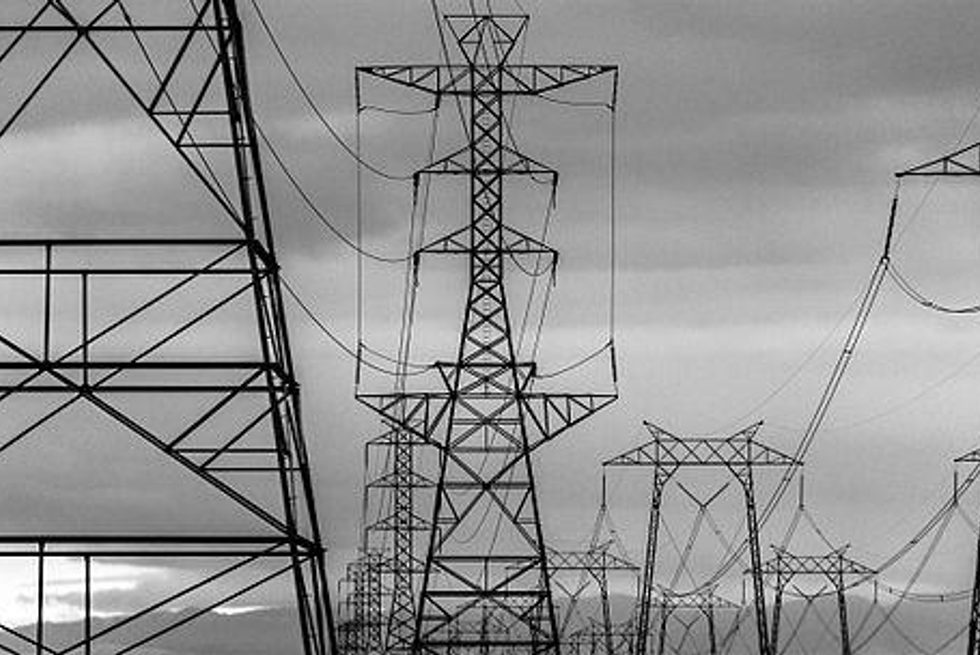Line Hum and Atmospheric Noise
From the Series: Book Forum on Marina Peterson's Atmospheric Noise: The Indefinite Urbanism of Los Angeles
From the Series: Book Forum on Marina Peterson's Atmospheric Noise: The Indefinite Urbanism of Los Angeles

hot lungs ready to roll tape, hillside capture
melts, snakes through snow
landscape line
hum
--David Grubbs, The Voice in the Headphones (2020, 8)
The measurement of sound as waves and the sensing of sound through a microphone “betrays a slippage across techno-rational registers,” Marina Peterson tells us in Atmospheric Noise (2021). It makes something that is “not air…nevertheless of air” (Peterson 2021, 113). Legal testimony of experiences with airport noise, noise measurement technology, noise pollution policy makers, butterfly enthusiasts; each inscribe their own rubrics of noise vis-à-vis air. Each betray their own instantiation of this messy slippage between the rational and the phenomenal. R. Murray Schafer’s “bluntly normative rejection of noise” (Peterson 2021, 120) frames the noise’s arrival. “There was an agreement that (noise) was a problem, and that it was a pollution” (Peterson 2021, 95). Noise annoys, Peterson reminds. Noise interrupts. Noise disrupts a particular mode of human residential life, a particular collection of human soundmarks. Noise belies human language. Noise clears space for the butterflies.
*
I speak formally of the structural acoustic isolation of recording studios. I do so, physically alone, in my bedroom, my virtual background shields the bedpost. It is a Recording Arts course in a pandemic year. It is being recorded, rather un-artfully. Students nod, or don’t, turn their cameras on, or off. Raise their virtual blue hands. Type questions into the chat. I show graphs of construction techniques. I speak of the artistic spectrum across the “dryness” of acoustic isolation to the “wetness” of acoustic concatenation. I’m a musician and cultural anthropologist, and so, I gloss the physics, de-emphasize the math. I stress the messiness of acoustic science, I ask them to hear and comprehend the specialized vocabulary of acoustic engineers as a historically specific code. Digital hieroglyphs. Analog ciphers.
“Line hum.” The sound of the recording equipment sending and receiving a particular kind of electrical signal in the absence of human sounds. The word “hum” is accurate, not as an onomatopoeia but as a directive. Make a continuous sound without opening your mouth. That’s the sound of line hum. It’s also the sound of “noise floor,” but the connotation is entirely different. The physics and ideology of line hum teach us that there is “harmonic content,” i.e., artistic potential, in the hum. “Noise” comes from most equipment and is treated by engineers with the bluntly normative rejection that Peterson historicizes. “Hum,” however, is sought after, fetishized, reconstructed. Microphones, pre-amps, amplifiers, and perhaps most iconically, magnetic tape, all have the potential to produce artful line hum. Interpreting the ciphers and hieroglyphs is partly in the difference between the hum and the noise.
*
“Noise is figured as signal’s other” (Peterson 2021, 29) within the Aerial Attunements of the residents near LAX whose lives are interrupted. Many audio engineers in the recent historical period of Peterson’s research, who might have tried building a recording studio there, would have agreed. Some contemporary words of advice from an audio engineering textbook reflect this prevailing ideology: “If there’s absolutely no choice of studio location and the studio happens to be located next to a recycling factory, just under the airport’s main landing path, or over the subway’s uptown line…you’ll simply have to give in to destiny and build acoustical barriers to these outside interferences” (Huber and Runstein 2018, 80).
There is an alternative ideology of sound measurement and capture however, an alternative way of categorizing and understanding the existence of “noise.” This concatenative ideology has something in common with the butterflies in Peterson’s ethnography who thrive amidst indefinite urbanism: “visuality and touch conjoin in an account of a count that is also an encounter” (Peterson 2021, 180). It is the synesthesia of any artist who relishes in atmospheric co-creation. It is a synthesis of signals that seeks out line hum, that facilitates “bleeding.” The bleeding of the sound of the drums into the vocal microphone, the bleeding of the sound of the cicadas into the sound of piano (Seretan 2020), the bleeding of the atmosphere into itself. The “hillside capture.” The “landscape line hum.”
Grubbs, David. 2020. The Voice in the Headphones. Durham, N.C.: Duke University Press.
Huber, David Miles, and Robert E. Runstein. 2018. Modern Recording Techniques. New York: Routledge.
Peterson, Marina. 2021. Atmospheric Noise: The Indefinite Urbanism of Los Angeles. Durham, N.C.: Duke University Press.
Sound Recordings
Seretan, Ben. Cicada Waves. Recorded 2020. NNA Tapes.